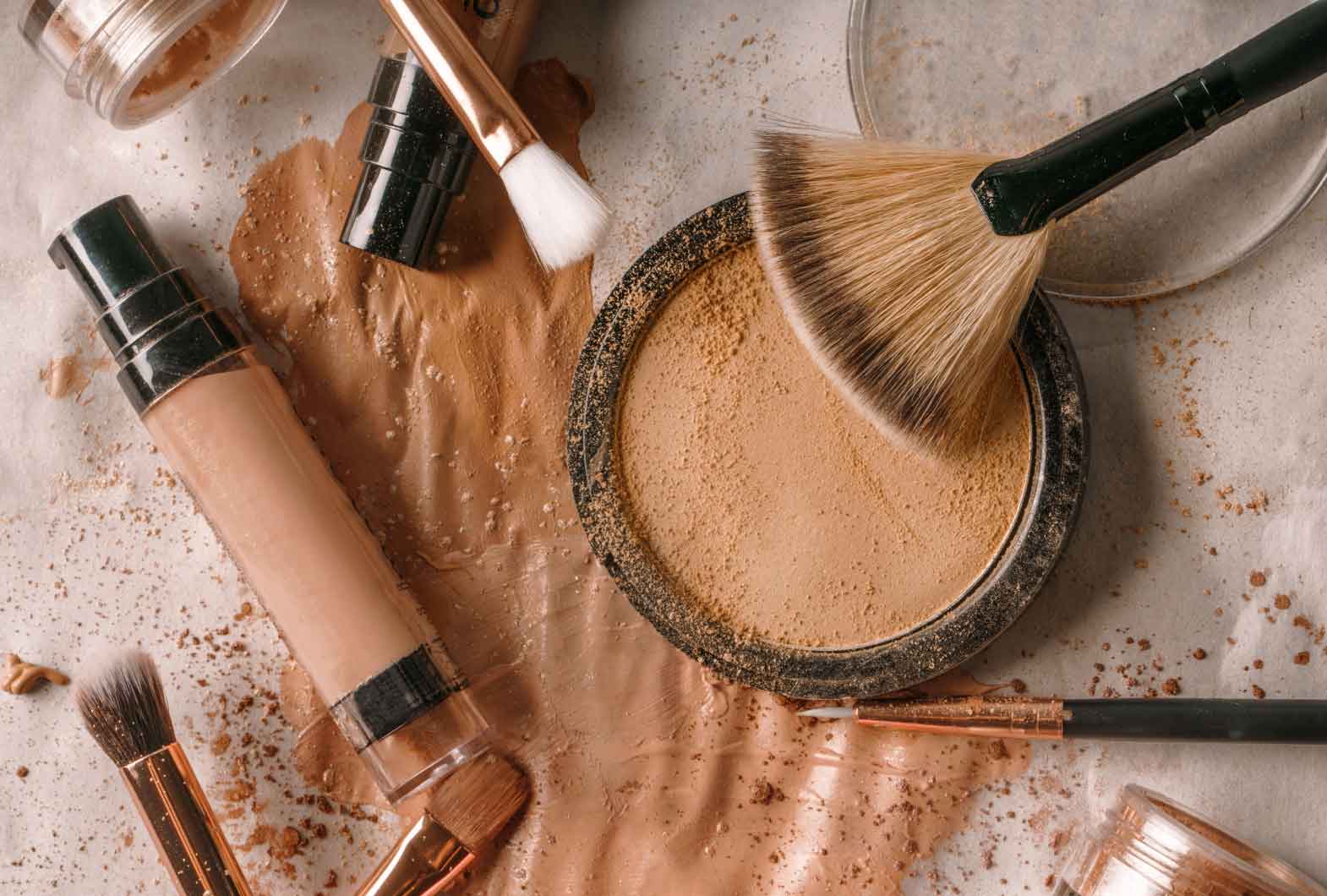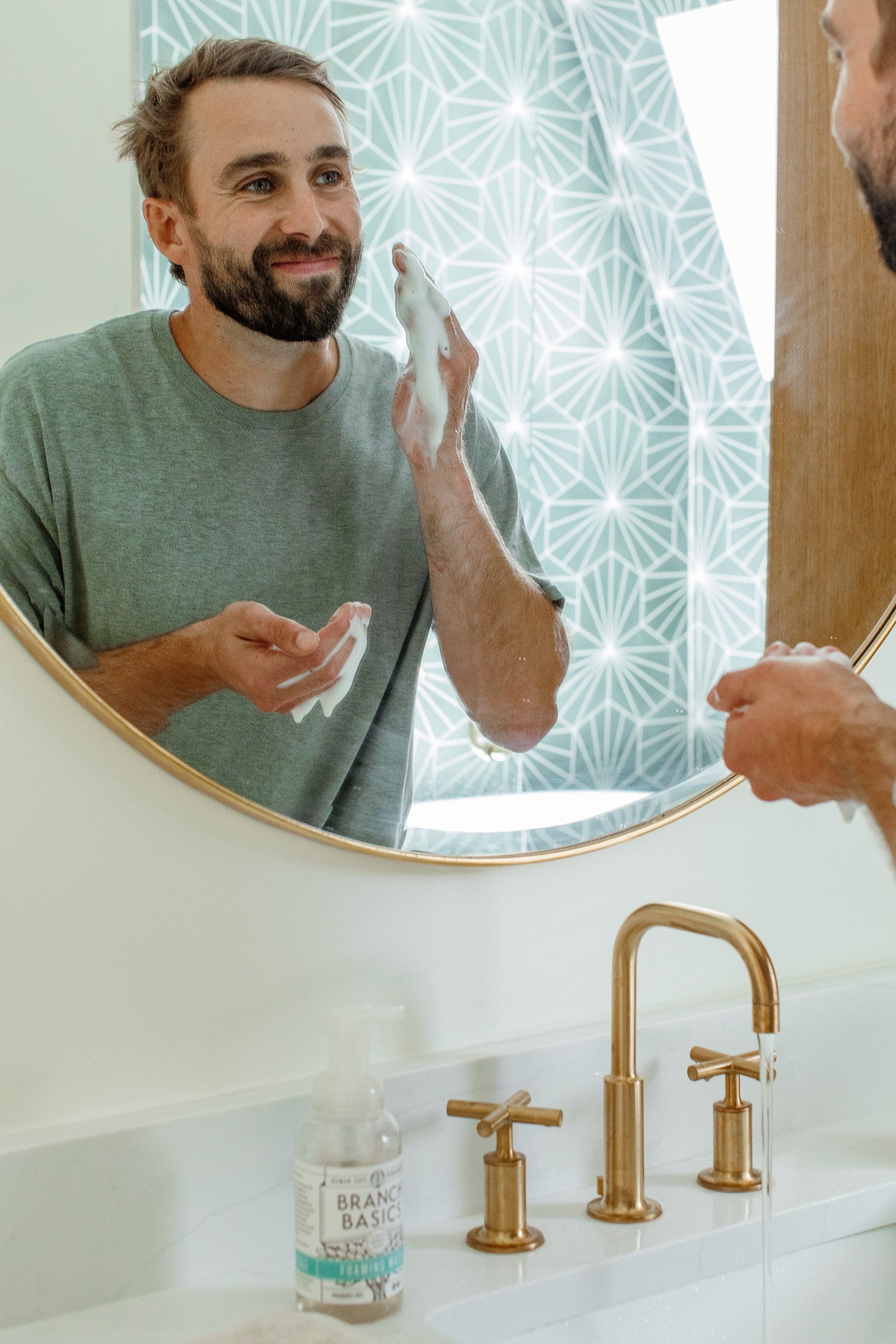Our Non-Toxic Makeup Recommendations

We often get the question, “What makeup do you use?” and let us tell you, makeup is tricky. We’ve sat down and not only compiled some of our favorite products that meet our standards but also information on popular ingredients in the clean beauty industry.
Our mission to help people create healthy homes and diet started after we discovered how much using and having products with harmful ingredients in our homes impacted our health.
While our Branch Basics products focus on cleaning, we are passionate about every product we bring into our homes. Products like makeup are especially important because the ingredients are placed directly on the skin and can enter the body.
Our goal is to equip you with the knowledge and resources needed to navigate the world of non-toxic makeup confidently. We're excited to share our insights with you, providing information on specific ingredients and their impact on your health. There are fantastic resources, like the EWG SkinDeep Database, Think Dirty app, and Beauty Heroes.
Vetting Ingredients with EWG
EWG Skin Deep is our favorite tool to rate cleaning, skin, beauty, and personal care products. We recommend that products kept in the home should ideally have all ingredients rated a 1 or 2 on EWG Skin Deep.
To vet ingredients yourself, go to EWG Skin Deep’s website and search for the ingredients on the product you are evaluating. EWG rates ingredients from 1-10, with one being the safest and 10 being the most toxic. We recommend tossing all products with an ingredient rated 3 or higher.
Pro tip: Start with the last ingredient on the list to save time. Typically you’ll find preservatives here and you may only have to look at one ingredient to find a rating of 3 or more. Once you find an ingredient rated three or above, look no more and toss!
While we recommend trying to find products with all ingredients rated 1 or 2, it is challenging, especially when looking for makeup. Our goal is to empower you with information that can be helpful in making decisions. We want you to become your own product advocate so you know how to look into each ingredient and learn how it works within the product you are considering!
When we initially wrote this blog post in 2019, we featured products with ingredients predominantly rated as 1s and 2s. It was and still is hard to find products in this category that meet our standards.
Since then, there have been shifts in product formulations and changes in ingredient ratings on EWG. These shifts occur due to new information or increased usage of certain ingredients across the industry.

Common Makeup Ingredients
We have looked at ingredients that are commonly found in cosmetics to shed more light on why we would or would not use products with these ingredients. Many of the ingredient ratings below from EWG depend on usage, how much of the ingredient is in the formula, and other factors.
Below are a few very common makeup ingredients that do not meet our typical standards of being 1 or 2 on the EWG Skin Deep scale but might be exceptions to consider when looking for safe makeup.
The order in which the ingredients appear on the label matters. The higher an ingredient appears on the list, the more it is in the product. Ideally, the following ingredients would be towards the bottom of the list.
-
Silica (1-3)
- Silica, similar to sand, is generally safe for cosmetics unless directly inhaled.
-
*Sodium benzoate (1-3)
- This preservative is widely used in many non-toxic makeup products. If you're prone to sensitivity, it's wise to monitor your skin's reaction. It is an ingredient we typically recommend avoiding, especially if you have sensitive skin, are prone to inflammation, or have chronic illness.
-
Iron oxides (3)
- These color pigments are standard in cosmetics and usually pose no significant concerns. However, we recommend avoiding pigments like Red Lake or chromiums.
-
Titanium dioxide (1-3)
- Primarily used as a whitener or pigment, titanium dioxide can irritate the lungs if inhaled, especially in sprays or powders.
-
Glyceryl behenate (1-3)
- This fat, used to increase viscosity, may cause irritation, particularly in products near the eyes or in spray form.
-
Zinc oxide (1-3)
- As a colorant and sunscreen agent, zinc oxide may pose respiratory risks, especially in sprays or powders.
-
*Citric acid (1-2)
-
We usually recommend avoiding citric acid, especially in food. While commonly used as a preservative or for its antibacterial properties, citric acid can cause redness and rashes in sensitive individuals. Exercise caution, especially if you have sensitive skin.
-
Camellia sinensis (green tea) leaf extract (2-4)
- Generally safe, though it may irritate sensitive skin. Monitor your skin's reaction when using products containing this extract.
-
Chamomilla recutita (matricaria) flower (2-4)
- Certain types of chamomile may irritate if inhaled from spray or powder products. If you are sensitive, look for products with allergen-free chamomile.
-
Sodium hydroxide (1-4)
- Also known as lye, sodium hydroxide, an ingredient in formulas, is safe once mixed with other ingredients.
-
Cinnamonum cassia (cinnamon) bark extract (3)
- Cinnamon powder, while natural, can be irritating, particularly with frequent use. Be mindful of products containing this ingredient if you have sensitive skin.
-
*Benzoic acid (1-3)
- A preservative similar to sodium benzoate may cause skin irritation, particularly for sensitive individuals.
-
Hydrolyzed wheat protein (1-4)
- Avoid if you have gluten sensitivities, as it may trigger allergic reactions.
Note: People trying to heal inflammatory skin conditions (such as eczema), hormone disruption, or chronic illness should also avoid products used on the skin with inflammatory ingredients (citric acid, sodium coco sulfate, phenoxyethanol, sodium benzoate, benzoic acid, potassium sorbate, and any ingredient with a quaternary ammonium component like polyquarternium).
Just as individuals can develop allergies to foods they frequently consume, our skin can become sensitized to even natural ingredients with regular or excessive use. To mitigate the risk of sensitivities, we encourage rotating products and ingredients in your routine.

Common Ingredients To Avoid
-
Dimethicone- 4
- Dimethicone, while widely used, has raised concerns due to evidence suggesting toxicity to our organs. It is also persistent in the body and doesn't detoxify quickly.
-
Phenoxyethanol- 4
- This commonly found preservative has faced scrutiny for its potential health risks. It can exacerbate and cause skin issues such as eczema and is a neurotoxin to infants. Notably, it has been identified as an endocrine disruptor and was temporarily banned by the European Union.
-
Tin Oxide
- This metal, often used in cosmetics for its reflective properties, can accumulate in the body over time, potentially harming organs.
-
Acacia Senegal Gum- 3
- Utilized as a thickening and binding agent, this ingredient has been associated with skin and respiratory irritation, even in small doses.
-
Ferric Ammonium Ferrocyanide- 1-4
- Found in many cosmetic products as a colorant, this salt has been linked to organ toxicity and can accumulate in the body.
-
Tocopheryl Acetate- 2-3
- Marketed as a synthetic form of vitamin E, tocopheryl acetate raises concerns about potential contamination with hydroquinone during production—a known bleaching agent harmful to humans. Additionally, it has been associated with skin irritation and bioaccumulation.
-
Dyes/Colorants
- The term 'lake' indicates pigments that are precipitated with metal salts (typically aluminum hydroxide). They may contain heavy metals or other toxic substances as part of their composition, and these substances can pose risks such as skin irritation or allergic reactions.
- These dyes contain chromium compounds, skin sensitizers and allergens capable of causing skin reactions, even in small concentrations. They also are bioaccumulative in the body. In addition, some chromium compounds, such as hexavalent chromium, are known carcinogens.
- Colorants with “lake” in the name (example: Red 6 and 7 Lake (CI 15850)
-
Chromium dyes (example: Chromium Hydroxide Green)
All About Essential Oils
Essential oils have been used for thousands of years as medicines, in perfumes, cosmetics, and to freshen the air. If used properly, they can be a powerful healing tool!
In today’s world, we are discovering an unintended consequence of the mass marketing and production of essential oils. I first became aware of an issue when I was working with clients with chronic illness thirty years ago. I had discovered that going completely fragrance-free was a critical point for the recovery of most of my clients.
Many were using essential oils as a healing tool. Some were using them constantly, diffusing oils, ingesting them, and using them on the skin. Removing all oils from the home, as I would guide them to go fragrance-free while healing, resulted in improvement or even resolution of symptoms. This happened over and over. We don’t realize how much they impact our health until they are removed!
My experience with clients started to be scientifically substantiated In 2007 when Anne Steineman began testing “green” products. All essential oils tested emitted hazardous chemicals with no significant difference between organic and non-organic. She also found emissions of harmful VOCs, from all fragranced products regardless of claims of organic, green, and non-toxic claims.
Many of my clients with endocrine disruption only had their condition resolved once essential oils were removed. Essential oils do not contain phthalates, but if they have been processed through plastic tubing, they pick up the phthalates which are endocrine disruptors. Studies have shown that harmful small particulates are released when certain essential oils are diffused impacting cognitive function.
The American Lung Association warns against inhaling essential oils directly and stresses that essential oils must only be used with care. The impact of essential oils from the terpene family on indoor air quality is a concern as levels of secondary pollutants such as formaldehyde and secondary organic aerosols/particulate matter (SOAs) are formed in the presence of ozone. Used improperly or manufactured with solvents or with plastic tubing, essential oils are a health threat to our families.
Our advice: Do an experiment and remove essential oils and products with essential oils from the home – don’t throw them away. After four to six weeks, experiment by bringing them back in, and see how you respond. This is tantamount to elimination diets. Reintroduce it to see if you react. If you react to the essential oils when you bring them back in the house - either wait longer and try again, or investigate the source of your essential oils to determine their purity.
If you find a pure essential oil after a fragrance-free trial in your home, make sure you do your due diligence about the proper use of essential oils.
Penetration Enhancers
Penetration enhancers help ingredients penetrate more deeply into products. When assessing a product containing these enhancers, it's important to scrutinize all ingredients. In EWG Skin Deep ratings, penetration enhancers are flagged with red flags
This heightened penetration increases the risk of skin irritation and other potential adverse effects. For instance, if a product contains both a penetration enhancer and sodium benzoate (known to be irritating), the likelihood of irritation is amplified due to increased skin penetration.
When using products containing retinols or other potent anti-wrinkle ingredients alongside penetration enhancers, sensitivity to the sun is heightened. This underscores the importance of carefully considering product formulations, especially in terms of their potential interactions and effects on skin health.

Our Recommended List of Non-Toxic Makeup
Here are some products we’ve found to be safe to use! New products come out all the time. Use EWG Skin Deep to expand your list.
Foundations & Tinted Moisturizers
- Ogee Sculpted Complexion Stick
- Iron Oxides: 3
- Juice Beauty Flawless Serum Foundation
- Silica: 1-3
- Sodium benzoate: 1-3
- Iron oxides: 3
- Araza All- in- one Coconut Cream Foundation
- Silica: 1-3
- Well People Bio Stick Foundation
- Iron oxides: 3
- Titanium dioxide: 1-3
- Sodium benzoate: 1-3
- Saie Glowy Super Skin
- Titanium dioxide: 1-3
- Iron oxides: 1-3
- Sodium benzoate: 1-3
- Toups & Co Liquid Foundation
- Titanium dioxide: 1-3
- Zinc oxide: 1-3
- Iron oxides: 3
- Piper Blue Organic Makeup
- Iron oxides: 3
- Silica: 1-3
Concealers
-
W3ll People BioCorrect (so great and a little goes a long way)
- Glyceryl behenate: 1-3
- Silica: 1-3
-
RMS Beauty “Un” Coverup
- Titanium dioxide: 1-3
- Iron oxides: 3
-
ATTITUDE Oceanly Eye Concealer
- Zinc oxide- : 1-3
- Glyceryl behenate- : 1-3
- Iron oxides: 3
- Rose Inc Softlight Luminous Hydrating Concealer
-
Coconut Corrective Cream Serum
- Silica: 1-3
-
Ilia Skin Serum Concealer
- Iron oxides: 3
- Titanium dioxide: 1-3
- Sodium Benzoate: 1-3
- Silica: 1-3
-
Toups & Co Concealer
- Titanium Dioxide: 1-3
- Iron Oxides: 3
Powders
- W3LL PEOPLE Bio Brightener Invisible Powder- 3
- Silica: 1-3
- Sodium benzoate: 1-3
- Camellia sinensis leaf extract- 4
- Kosas Cloud Set Powder
- Iron oxides: 3
- Titanium dioxide: 1-3
- Ilia Soft Focus Finishing Powder
- Silica: 1-3
- Toups & Co Organics Mineral Makeup
- Zinc oxide: 1-3
- Titanium dioxide: 1-3
- Iron oxides: 3
- 100% Pure Bamboo Blur Powder
- Silica: 1-3
Bronzers
- 100% Pure Natural Bronzer
- Ogee Sculpted Face Stick
- Titanium dioxide: 1-3
- Iron oxides: 3
- Piper Blue Organic Makeup
- Iron oxides: 3
- Silica: 1-3
- Toups & Co Organics Bronzer
- Titanium dioxide: 1-3
- Iron oxides: 3
- Lawless Beauty Summer Skin Velvet Matte Bronzer
- Iron oxides: 3
Blushes
- Tinted Lip Balm: French Kisses*– this works on cheeks for blush as well as a great tinted lip balm
- Iron oxides: 3
- Ogee Sculpted Face Stick
- Titanium dioxide: 1-3
- Iron oxides: 3
- Toups & Co Cream Cheek Tint
- Titanium dioxide: 1-3
- Iron oxides: 3
- Toups & Co Organics Natural Pressed Blush
- Titanium dioxide: 1-3
- Iron oxides: 3
- Piper Blue Organic Makeup
- Iron oxides: 3
- Silica: 1-3
- 100% Pure Fruit Pigmented Blush
Highlighters
- Ogee Sculpted Face Stick
- Titanium dioxide: 1-3
- Iron oxide: 3
- Toups & Co Cream Luminizer Pot
- Iron oxides: 3
Eye Shadows
- Jillian Dempsey Lid Tint
- Titanium dioxide: 1-3
- Iron oxides: 3
- Toups & Co Organics Natural Eye Makeup Palette
- Titanium dioxide: 1-3
- Iron oxides: 3
- 100% Pure Fruit Pigmented Better Naked Palette

Eyeliners
- Rituel de Fille Pot
- Silica: 1-3
- Iron oxides: 3
- Mineral Fusion Eye Pencil
- Silica: 1-3
- Titanium dioxide: 1-3
- Iron oxides: 3
- Toups & Co Organics Natural Eye Liner
- 100% Pure Creamy Long Lasting Liner
- Iron oxides: 3
Mascara
- Rimmel London Kind 7 Free Clean Mascara Black
- Ilia Limited Lash Mascara
- Sodium benzoate: 1-3
- Benzoic acid: 1-3
- Iron oxides: 3
- Crunchi Mascara
- Iron oxides: 1-3
- Sodium hydroxide- 4
- 100% Pure Fruit Pigmented® Ultra Lengthening Mascara*
- Hydrolyzed wheat protein: 1-4
- Saie Mascara 101
- Iron oxides: 3
- Sodium benzoate: 1-3
Eyebrows
- AuNaturale Brow Boss Pencil
-
Kosas Brow Pop
- Iron oxides: 3
-
Ilia In Full Micro-Tip Brow Pencil
- Titanium dioxide: 1-3
- Iron oxides: 3
-
Toups & Co Organics Brow Pencil
- Tocopheryl acetate: 2-3
- Titanium dioxide: 1-3
- Iron oxides: 3
Lips
- Dr. Barbara Sturm Lip Balm
- Tinted Lip Balm: French Kisses
- Saie Lip Blur, Nouveau
- Ogee Full Bloom Sculpted Lipstick
- Titanium dioxide: 1-3
- Iron oxides: 3
- Toups & Co Nourishing Lipstick
- Titanium dioxide: 1-3
- Iron oxides: 3
- Toups & Co Organic Lip Gloss
- Titanium dioxide: 1-3
- Iron oxides: 3
- Toups & Co Organics Tinted Lip Balm
- 100% Pure Fruit Pigmented Cocoa Butter Matte Lipstick
- Silica: 1-3
- 100% Pure Fruit Pigmented Pomegranate Oil Lipstick
- 100% Fruit Pigmented Lip Gloss
- 100% Pure Fruit Pigmented Lip Glaze
Brushes
Sunscreen for the Face
Being Your Own Product Advocate
The best part of being a knowledgeable consumer is that YOU get to take control of what goes onto your skin. We highly recommend looking through this blog on being your own product advocate so that you can continue to make informed decisions on all products, not just cosmetics!
Our intention is to arm you with the information you need to identify and toss products and foods with harmful ingredients and replace them with truly safe ones. We want to empower you to become your own advocate so you can Create a Healthy Home!
Let’s continue pushing makeup brands and companies to provide products with cleaner, non-toxic ingredients so everyone (including our pets and planet) can reap the benefits!
Remember, take it one step at a time and evaluate your current products before purchasing new ones! Maybe the products you already have meet the standards above. You got this!
Further Reading
Categories

Marilee Nelson
Marilee Nelson is an Environmental Toxins expert who has spent nearly 30 years advocating for the chemically-sensitive and chronically-ill. She is a Board Certified Nutritionist, Certified Bau-Biologist and Bau-Biology Inspector and specializes in Food As Medicine. She has helped thousands of families and individuals identify, heal and recover from toxic exposures and is on a mission to revolutionize the way American families view their health.








